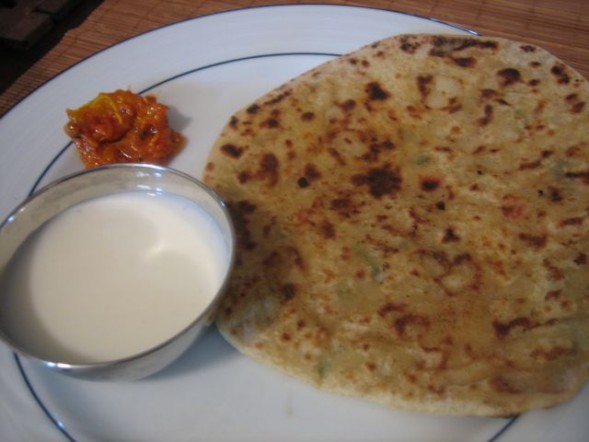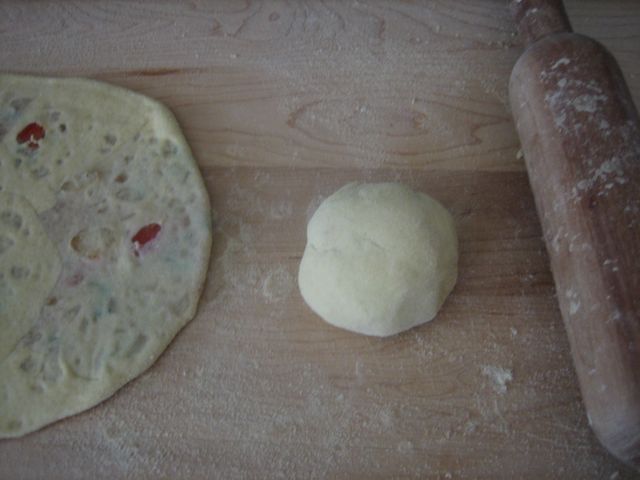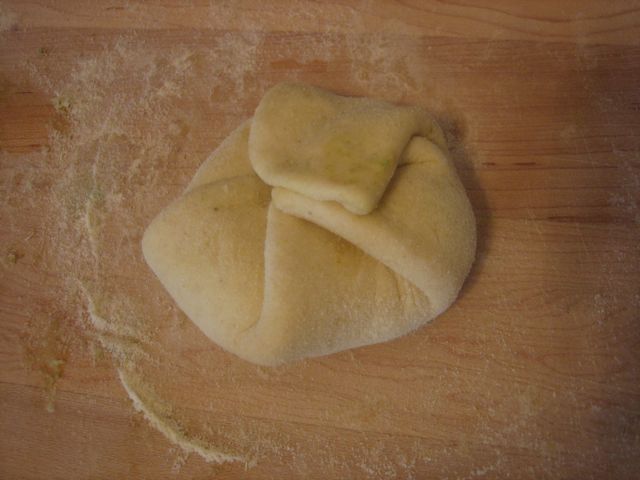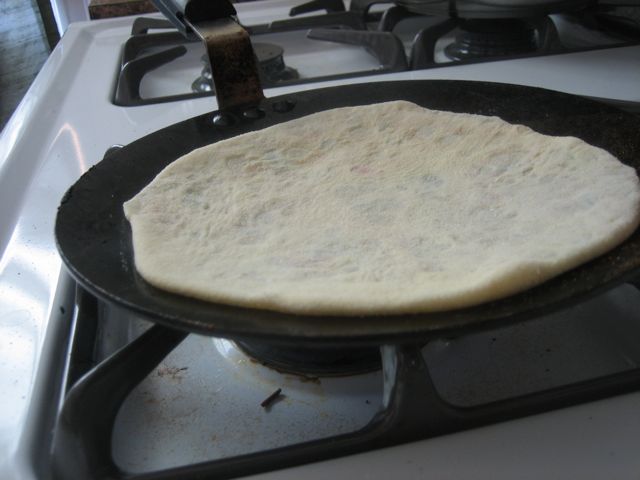
Warm, generously filled parathas (stuffed Indian flatbread) remind me of cold, wintery mornings at my husband�EUR(TM)s family�EUR(TM)s house in Delhi. We wake up to be treated to hot parathas and steaming chai. Despite our �EURoeprotests�EURoe against such a heavy breakfast and �EUR�pleas�EURoe for no butter, we let our plates be filled with hot paratha after hot paratha, even getting bold enough to make a special request for Gobi Parathas the next morning.
One reason I love cooking is because it lets me recreate, through food, cherished memories of places and loved ones. So, while Indian bread making has always been a a challenge for me, the task of making Aloo Parathas was a test I was willing to work at. I assure you – while it�EUR(TM)s a time consuming activity, it�EUR(TM)s really not that hard. And when you dip the spicy, potato filled bread into yogurt, top it with a smear of lemon pickle and place it in your mouth, you�EUR(TM)ll be immediately transported to that warm place where aunties buzz busily around you, taking care of your every want, seeing to it that your belly is full and your plate even fuller.
Parathas can be made in many different varieties – gobi, channa daal, methi, mint and paneer are among some of the more common…what’s your favorite?
| Aloo Parathas (Spiced Potato Filled Flatbread) ~makes about 12~ Dough: Aloo Filling: *Amchur powder gives the potato filling a tangy, sour kick. You can substitute chaat masala or anardhana (pomegranite powder). If you don’t have any of those, use a splash of lemon juice. Preparing the Dough: 1. Pour the atta (flour) into a large steel bowl. My MIL�EUR(TM)s tip is to then sift through it with a sieve, but since I don�EUR(TM)t own one and b/c I think step is largely for situations where your atta may have undesirables in it (i.e. flour bugs and weevils) and mine was fresh and stored in the freeze, we skipped this step. 2. Mix in about 1 tspn. salt. 3. Slowly pour the water into the bowl a little at a time. Resist the urge to pour all of the water in. The flour will start to turn into small doughy pieces. Work your way through the flour portions at a time, adding more water as the flour is transformed into dough and kneading portions as you go – using only as much water as is necessary to get soft, elastic-y ball of dough. 4. Once all of the flour has been transformed into dough, rub a thin layer of water over the surface of the dough ball and give it three or four good kneads with your fist. Let the dough sit for about 5 minutes. 5. Rub another thin layer of water over the surface of the dough ball and give it another three or four good kneads. Put it into an air tight container and store in the refrigerator. Preparing the Aloo Filling: 1. Take the boiled and peeled potatoes and finely mash them. You should use a masher or ricer, but seeing as we don�EUR(TM)t own either of those kitchen utensils, we used our hands and a wooden spoon. Try to get as many lumps out of the potatoes as possible b/c they make rolling difficult. 2. Chop the tomato in half and then squeeze the water out like you would squeeze a lemon. The seeds and tomato juice should come out. 3. Finely dice the tomato and mix it into the aloo. 4. Mix in the remaining ingredients and spices. Adjust the spice and salt to taste. If the aloo tastes under spiced, just add a little of each dry masala in a similar proportion. 5. Tear off portions of the aloo mixture and roll into balls between your palms. Making the Parathas: Set up your workspace. Use a wooden cutting board sprinkled with atta to prevent sticking. Keep another bowl of atta handy for the rolling process. 1. Tear off a piece of the dough and make a ball by rolling it between your palms. The ball should be a little bigger than a golf ball. 2. Dip the ball into the bowl of atta and shake off the excess atta. Place the ball on the floured surface and roll it out into a circle. 3. Place the aloo ball in the middle of the dough. Gently press it down with your thumb. 4. Fold the dough over the aloo – first the back flap, then the left side, the right side then the front flap. Press the center down then dip the disc into the bowl of atta and shake off the excess atta. 5. Flour the surface again. Place the disc with the folds up. Gently roll out the disc out. You may be able to see the stuffing a little through the dough but don�EUR(TM)t despair. Just keep on rolling on until you have a thin, wide disc. 6. Place the paratha onto an oiled, hot tawa (iron skillet). Let it cook on each side until golden brown with some golden brown spots. Use a spoon to smear a little oil onto each side of the paratha and cook again for about 30 seconds on each side. You can use less oil for this step but don�EUR(TM)t skip it because the paratha will get too dry…just use less oil and either canola or olive oil. |



15 responses to “Aloo Paratha – Spiced Potato Filled Flatbread”
Aloo paranthas look simply delicious and they are my favorites. Good that you posted this recipe. I completely forgot to make them at home.Tomatoes seems to be a good addition.
Foodie, thanks! The tomatoes do go well…just be sure to squeeze the juice and seeds out.
Raj, get Guru to make you some parathas…then you won’t be hungie.
Stephanie, thanks! I’m glad you found my blog. What’s in your dhaba? So, I passed your question along to a friend with gluten allergies, Swati, and here’s what she says, “That’s funny because I saw your blog today and thought, man, i would really love to eat that – how can i make it gluten free? 🙂 My mom has made me thepla (a gujarati paratha with methi in it) using buckwheat flour before. Not sure if it will hold up well with the stuffing, but worth a try! You can get buckwheat at any organic grocery store like whole foods. I think I bought the Arrowhead Mills kind.” Let me know if you try it – I would love to hear about it.
Making me hungie!
I am a wheat-free vegetarian who has found your site. I love it! My most prized cooking possession is the dhaba (?) given to me by my law school roomie.
So my question: Are there any appropriate alternatives to wheat for making paratha or naan? I could try with spelt and see how it goes… I miss it desperately.
I do love parathas in the morning….its so filling, but I always reserve such treats for weekend brunches….Aloo Parathas are a favorite of mine with dahi-lasan chutney and a steaming cup of ginger tea. Your parathas with a plum tomato look good, they take a lot of practice to get itjust right, but so worth it!
Trupti, for some reason our stomach seems to expand when in India. Back home in the US, parathas are either only for a weekend brunch or a light dinner. I tried a few peas parathas but think I need more practice before I can get those right…the aloo were much easier!
Those Parathas look good! I like the sound of filling a flat bread!
Kevin, thanks for stopping by – so happy to have found your blog! Agreed – it’s like flat bread isn’t yummy enough…someone thought to go and stuff them with spicy potatoes
I think I’m finally going to make this! A birthday present for myself this weekend 🙂
Can you help define the proportions a little? I get that the balls of dough should be a little larger than a golfball. How big are the balls of aloo?
And how thin?
Thanks!
@ Stephanie – The dough balls should be a little bigger than the size of a golfball, and the aloo balls should be about the same size. The first time you roll the dough out, it doesn’t have to be super thin. After you put the aloo in and fold over then re-roll, you’ll want to roll the paratha out to be pretty thin. Otherwise, the parathas will be pretty doughy. You’ll get the hang of it after the first few. And if some of the filling peeks through the skin of the dough when you’re rolling, don’t despair. And remember, flour is your friend. Good luck and happy birthday!
Totally missed your answer! But made them last night, and it was a big hit! I used whole spelt flour, and made some with chiles and some without (tastes of the guests…). And amchur powder–my new favorite seasoning! I gave it to the teenagers who were over, and they agreed it’s better than the sour junk they sell in the candy aisle now.
I probably used a bit less aloo than you say, maybe 2/3 as much as the dough? I wasn’t worried about it peeking out, but some would come squirting out the edges!
The aloo paratha was a great accompaniment for Heidi’s Pan-fried Chickpea Salad (101 Cookbooks) when were weren’t intending a full Indian meal.
Thanks for all your help!
Hi Stephanie, sorry! I should have sent it by email. I’m so glad to hear that they were a hit and to know that spelt works well with this! I agree that amchur is delicious. It reminds me a little of the sour dip sticks we are when we were kids. Nice to know this goes well with Heidi’s salad…saw it the other day and it looks yummy.
The amount of aloo to the dough and the rolling is definitely more of an art than a science. Sounds like you found the right balance.
Nithya
Hi,
After stuffing the dough with the potatoes, how do you prevent the dough from tearing when you try to roll it out again?
Sneha
ND: Part of the trick is how you roll out the dough. Spread a little flour on the rolling surface and flour the dough as well. Put the rolling pin on top of the dough and roll the pin while keeping your palms spread open and flat (rolling the pin under your open palms). You should be pressing lightly enough that the dough can sort of slowly spin in a circle while you’re rolling. Although, even if the dough tears a little and the fillings show through, your parathas will still turn out well and actually after they are cooked, you probably won’t even see the cracks. Good luck!
Thanks for publishing this recipe – found it months ago, yet didn’t have a chance to make it until yesterday. First batch turned out ok, but not great … ended up denser than I’d remembered my grandmother’s parathas of old being 😉 With the second batch I tried a couple of variations – first, I brushed the open paratha with oil (didn’t have ghee, so used grapeseed oil) before stuffing & folding it … wife said that was the best one yet, and I’d agree.
Second was to try an unstuffed variation with layers, using the “square” technique they show here…
http://www.indiacurry.com/bread/br007pratha.htm
This one was really very good, had some air bubbles in place, etc …. seemed lighter than any in the first batch (of which I’d made both stuffed & unstuffed ones), and imho was the best yet, followed closely by the “oiled & stuffed” version.
Thanks again – this recipe’s a keeper! 🙂
@Ali S – I’m glad that you were able to try it out and enjoyed the recipe. We just made a batch over the holidays, and you definitely have to get the right stuffing to bread ratio and use a well oiled pan when cooking each paratha because otherwise they can be a bit dry. Thanks for the comment!